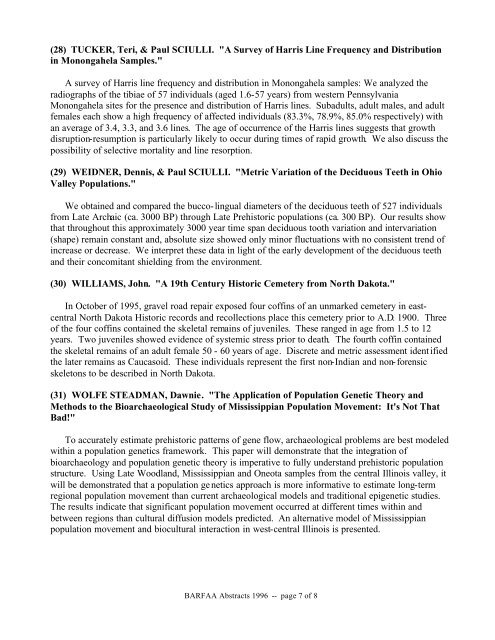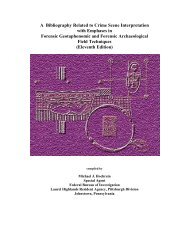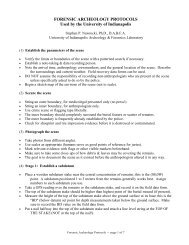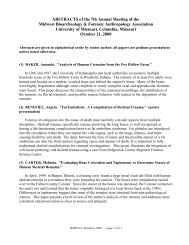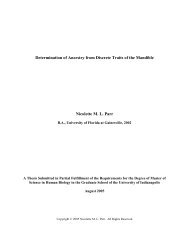Abstracts - University of Indianapolis Archeology & Forensics ...
Abstracts - University of Indianapolis Archeology & Forensics ...
Abstracts - University of Indianapolis Archeology & Forensics ...
Create successful ePaper yourself
Turn your PDF publications into a flip-book with our unique Google optimized e-Paper software.
(28) TUCKER, Teri, & Paul SCIULLI. "A Survey <strong>of</strong> Harris Line Frequency and Distribution<br />
in Monongahela Samples."<br />
A survey <strong>of</strong> Harris line frequency and distribution in Monongahela samples: We analyzed the<br />
radiographs <strong>of</strong> the tibiae <strong>of</strong> 57 individuals (aged 1.6-57 years) from western Pennsylvania<br />
Monongahela sites for the presence and distribution <strong>of</strong> Harris lines. Subadults, adult males, and adult<br />
females each show a high frequency <strong>of</strong> affected individuals (83.3%, 78.9%, 85.0% respectively) with<br />
an average <strong>of</strong> 3.4, 3.3, and 3.6 lines. The age <strong>of</strong> occurrence <strong>of</strong> the Harris lines suggests that growth<br />
disruption-resumption is particularly likely to occur during times <strong>of</strong> rapid growth. We also discuss the<br />
possibility <strong>of</strong> selective mortality and line resorption.<br />
(29) WEIDNER, Dennis, & Paul SCIULLI. "Metric Variation <strong>of</strong> the Deciduous Teeth in Ohio<br />
Valley Populations."<br />
We obtained and compared the bucco-lingual diameters <strong>of</strong> the deciduous teeth <strong>of</strong> 527 individuals<br />
from Late Archaic (ca. 3000 BP) through Late Prehistoric populations (ca. 300 BP). Our results show<br />
that throughout this approximately 3000 year time span deciduous tooth variation and intervariation<br />
(shape) remain constant and, absolute size showed only minor fluctuations with no consistent trend <strong>of</strong><br />
increase or decrease. We interpret these data in light <strong>of</strong> the early development <strong>of</strong> the deciduous teeth<br />
and their concomitant shielding from the environment.<br />
(30) WILLIAMS, John. "A 19th Century Historic Cemetery from North Dakota."<br />
In October <strong>of</strong> 1995, gravel road repair exposed four c<strong>of</strong>fins <strong>of</strong> an unmarked cemetery in eastcentral<br />
North Dakota Historic records and recollections place this cemetery prior to A.D. 1900. Three<br />
<strong>of</strong> the four c<strong>of</strong>fins contained the skeletal remains <strong>of</strong> juveniles. These ranged in age from 1.5 to 12<br />
years. Two juveniles showed evidence <strong>of</strong> systemic stress prior to death. The fourth c<strong>of</strong>fin contained<br />
the skeletal remains <strong>of</strong> an adult female 50 - 60 years <strong>of</strong> age. Discrete and metric assessment identified<br />
the later remains as Caucasoid. These individuals represent the first non-Indian and non-forensic<br />
skeletons to be described in North Dakota.<br />
(31) WOLFE STEADMAN, Dawnie. "The Application <strong>of</strong> Population Genetic Theory and<br />
Methods to the Bioarchaeological Study <strong>of</strong> Mississippian Population Movement: It's Not That<br />
Bad!"<br />
To accurately estimate prehistoric patterns <strong>of</strong> gene flow, archaeological problems are best modeled<br />
within a population genetics framework. This paper will demonstrate that the integration <strong>of</strong><br />
bioarchaeology and population genetic theory is imperative to fully understand prehistoric population<br />
structure. Using Late Woodland, Mississippian and Oneota samples from the central Illinois valley, it<br />
will be demonstrated that a population genetics approach is more informative to estimate long-term<br />
regional population movement than current archaeological models and traditional epigenetic studies.<br />
The results indicate that significant population movement occurred at different times within and<br />
between regions than cultural diffusion models predicted. An alternative model <strong>of</strong> Mississippian<br />
population movement and biocultural interaction in west-central Illinois is presented.<br />
BARFAA <strong>Abstracts</strong> 1996 -- page 7 <strong>of</strong> 8


